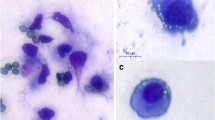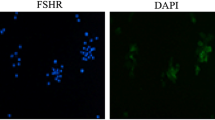Abstract
The aim of the present study was to investigate the effects of recombinant human anti-mullerian hormone (rhAMH) on Stem Cell Factor (SCF) expression in human granulosa cells (GCs). GCs were obtained from infertile patients undergoing IVF-ET cycles and cultured with 20 ng/ml of rhAMH. The levels of SCF mRNA and protein were detected in both matched and experimental group by real-time PCR, immunofluorescence, and ELISA, respectively, on day 4 of culture. We found that human GCs expressed SCF mRNA and protein, and SCF expression in the experimental group was significantly lower than that in the matched group (p < 0.05). We further showed that rhAMH inhibited SCF expression at mRNA and protein levels.



Similar content being viewed by others
References
Durlinger, A. L., Gruijters, M. J., Kramer, P., Karels, B., Ingraham, H. A., Nachtigal, M. W., et al. (2002). Themmen. Anti-mullerian hormone inhibits initiation of primordial follicle growth in the mouse ovary. Endocrinology, 143, 1076–1084.
McLaughlin, E. A., & McIver, S. C. (2009). Awakening the oocyte: Controlling primordial follicle development. Reproduction, 137, 1–11.
Hu, R., Zhang, X. M., & Wu, X. (2009). Anti-mullerian hormone (AMH) predict ovarian reserve and reactivity studies. Reproduction and Contraception, 29, 515–519.
Nilsson, E., Rogers, N., & Skinner, M. K. (2007). Actions of anti-mullerian hormone on the ovarian transcriptome to inhibit primordial to primary follicle transition. Reproduction, 134, 209–221.
Reynaud, K., Cortvrindt, R., Smitz, J., Bernex, F., Panthier, J. J., & Driancourt, M. A. (2001). Alterations in ovarian function of mice with reduced amounts of KIT receptor. Reproduction, 121, 229–237.
Pepinsky, R. B., Sinclair, L. K., Chow, E. P., Mattaliano, R. J., Manganaro, T. F., Donahoe, P. K., et al. (1988). Proteolytic processing of mullerian inhibiting substance produces a transforming growth factor-beta-like fragment. Journal of Biolological Chemistry, 263, 18961–18964.
Visser, J. A., & Themman, A. P. (2005). Anti-mullerian hormone and folliculogenesis. Molecular Cellular Endocrinology, 234, 81–86.
Lambalk, C. B., Van Disseldorp, J., De Koning, C. H., & Broekmans, F. J. (2009). Testing ovarian reserve to predict age at menopause. Maturitas, 63, 280–291.
Marca, A. La., Orvieto, R., Giulini, S., Jasonni, V. M., Volpe, A., & De Leo, V. (2004). Mullerian-inhibiting substance in women with polycystic ovary syndrome: relationship with hormonal and metabolic characteristics. Fertility and Sterility, 82, 970–972.
Hu, R., & Zhang, X. M. (2009). Anti-mullerian hormone effects secretory function of human luteinized granulosa in vitro. Ningxia Medical Journal, 31, 868–870.
Kanakkaparambil, R., Singh, R., Li, D., Webb, R., & Sinclair, K. D. (2009). B-vitamin and homocysteine status determines ovarian response to gonadotropin treatment in sheep. Biology of Reproduction, 80, 743–752.
Chang, L. C., Guo, C. L., Lin, Y. S., Fu, H., Wang, C. S., & Jauh, G. Y. (2009). Pollen-specific SKP1-like proteins are components of functional scf complexes and essential for lily pollen tube elongation. Plant Cell Physiology, 50, 1558–1572.
Da Silva, C. A., Kassel, O., Lebouquin, R., Lacroix, E. J., & Frossard, N. (2004). Paradoxical early glucocorticoid induction of stem cell factor (SCF) expression in inflammatory conditions. British Journal of Pharmacology, 141, 75–84.
Gong, Y., Li, S. W., & Fan, W. (2011). Insulin affects on cultured of mice ovarian granulosa cells Foxo1mRNA expression. Practical Obstetrics and Gynecology, 27, 368–370.
Acknowledgments
This work was supported by Grants from National Natural Science Foundation of China (No. 81260109); Natural Science Foundation of Ningxia Province, China (No. NZ10115); and State Key Foundation of Science and Technology of Ningxia, China (No. 2010297).
Conflict of interest
The authors report no conflicts of interest. The authors alone are responsible for the content and writing of the article.
Author information
Authors and Affiliations
Corresponding author
Rights and permissions
About this article
Cite this article
Hu, R., Lou, Y., Wang, FM. et al. Effects of Recombinant Human AMH on SCF Expression in Human Granulosa Cells. Cell Biochem Biophys 67, 1481–1485 (2013). https://doi.org/10.1007/s12013-013-9649-x
Published:
Issue Date:
DOI: https://doi.org/10.1007/s12013-013-9649-x




